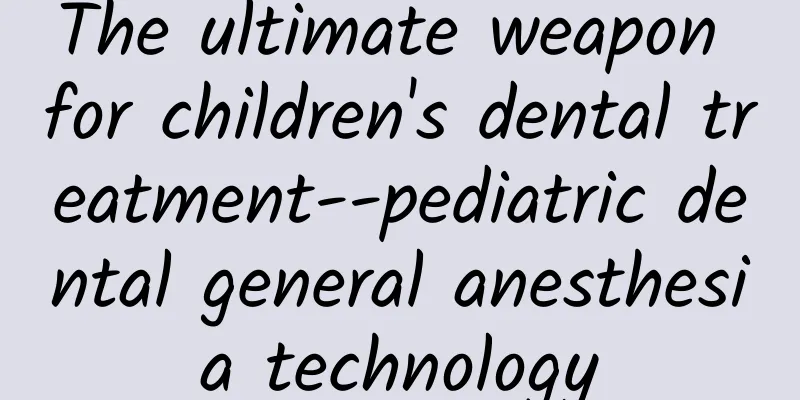The ultimate weapon for children's dental treatment--pediatric dental general anesthesia technology

|
With the enhancement of people's awareness of oral health care and the improvement of living standards, children's oral diseases have attracted more and more attention. However, for some young children or special children with intellectual or physical disabilities, they often have fear or crying emotions and cannot cooperate well with outpatient oral treatment. This situation not only makes parents very worried, but also makes the treatment of dentists very difficult. In recent years, with the continuous advancement of the country's healthy China concept of "loving science, advocating innovation, and flying with both wings", the concept and technology of "comfortable treatment" have been increasingly applied to clinical treatment. Among them, pediatric dental general anesthesia technology combines anesthesia technology with pediatric oral treatment technology, adhering to the concept of safety and painlessness, and perfectly solves the dilemma of children not cooperating with dental care, parents are very worried, and doctors have no countermeasures. "Waking up, white teeth" is no longer a picture in mind! As the ultimate weapon for children's diagnosis and treatment, pediatric dental general anesthesia technology solves children's oral problems at one time, which plays an important role in promoting the development of a harmonious society and promoting family harmony! What is dental anesthesia? It refers to a behavioral management technique that uses anesthetic drugs (inhaled gas or injected drugs, or a combination of inhalation and injection) to put the patient into an unconscious state, completely without the ability to maintain physiological functions independently, and implement dental treatment under strict supervision. This technology is performed jointly by experienced dentists, nurses and well-trained anesthesiologists. Generally speaking, pediatric oral general anesthesia is a surgical method that performs one-time oral treatment and oral prevention and protection on children with oral diseases under general anesthesia (general anesthesia for short). This surgery is usually performed in an outpatient operating room and often does not require hospitalization. At the same time, during the entire process of preoperative evaluation, intraoperative operation, and postoperative awakening, dentists, nurses, and anesthesiologists will form a team to join forces and collaborate rigorously to ensure the safety and smooth progress of the surgery! Which children are suitable for "general anesthesia dental treatment" surgery? 1. Age limit: Children over 3 years old. Children over 3 years old have basically completed their nervous system and metabolic system, and have a good tolerance for anesthesia and surgery, and are relatively safe. 2. Children with dental phobia: Children have anxiety, tension or fear during dental treatment, which is manifested in increased sensitivity, decreased tolerance, and even avoidance of treatment. 3. Parents and children who have a lot of tooth decay and are away from home or have limited time: The main advantage of pediatric dental general anesthesia technology is that it can solve the problems in the oral cavity at one time through anesthesia, thus reducing the patient's diagnosis and treatment cycle and saving parents' precious time. 4. Children with intellectual or systemic problems cannot cooperate with treatment, including children with cerebral palsy, autism, intellectual disability, etc. Generally, these children have difficulty in living a normal life, especially oral care. Children's dental general anesthesia technology is very suitable for solving the oral problems of these children. 5. Qualified pre-anesthesia assessment: The prerequisite for the implementation of dental general anesthesia technology is a good physical condition that is suitable for anesthesia. Although the risk of general anesthesia is extremely low and controllable, parents are required to inform the doctor of the child’s health status before the operation and complete the examination items required by the doctor. Only children who can tolerate the operation and meet the general anesthesia indicators can undergo the operation. What oral problems can be solved by general anesthesia surgery in children? Oral problems treated with general anesthesia in pediatric dentistry cover all basic problems in outpatient oral treatment, including filling and crown restoration of decayed teeth; endodontic treatment (root canal treatment, pulpotomy, etc.) of teeth with pulpitis and periapical disease; and of course, surgical problems such as tooth extraction, space maintenance, window traction, and lip and tongue frenulum repair. Preventive treatment includes fluoride coating, pit and fissure sealing, preventive filling, etc. It can be said that anesthesia is not easy once. During the operation, all oral problems will be solved as much as possible, and some prevention and protection will be done in advance for possible dental problems in the future. Will general anesthesia surgery affect children's intelligence? At present, the most concerned issue for parents is whether general anesthesia will affect the physical development or intelligence of children? First of all, from the perspective of age, we generally choose children over 3 years old as the appropriate population for surgery, avoiding the golden period of rapid growth before the age of 3. Secondly, in terms of the use and metabolism of anesthetics, the current anesthesia method used for general anesthesia is intravenous inhalation combined anesthesia. During the operation, anesthetics are injected intravenously and inhaled into the lungs, and reach the nerve center-the brain through the blood circulation, blocking the bioelectric transmission between synapses, so as to inhibit the child's consciousness and block the transmission of pain. This blockade is controllable and reversible, and its effect on the nerve joint is transient. With the end of the operation, the anesthetic will be excreted from the body, the inhaled anesthetic will be excreted in its original form through the lungs, and the intravenous anesthetic will also be converted into harmless substances in the body and excreted with urine, and the nerve function will be restored accordingly, and there will be no "effects" left. The most commonly used anesthetic in clinical practice is propofol, which has certain side effects as a drug. Some children have a dull expression and slow reaction during the postoperative recovery period because the child's metabolic rate is low, the excretion function is poor, and there is still a certain amount of anesthetics in the child's blood. This phenomenon is a normal metabolic process of anesthetic drugs, and parents do not need to worry too much. Finally, from some domestic and foreign studies, such as the team of Xia Bin from the Department of Pediatric Dentistry and Anesthesiology of the School of Stomatology and Hospital of Stomatology of Peking University School of Stomatology, they used the Chinese-Wechsler Preschool and Early School-age Intelligence Scale (City Edition) to evaluate the intelligence of some children who used dental general anesthesia technology. The results showed that the use of sevoflurane, nitrous oxide, and propofol for 2-4 hours of general anesthesia for dental treatment in children aged 4.0 to 6.5 years did not reduce the children's Wechsler Intelligence Scale scores in the short term. Due to its outstanding advantages, pediatric dental general anesthesia technology has become the most commonly used behavioral management method for children who are ineffective with conventional behavioral management methods. In recent years, it has received attention and recognition from pediatric dentists around the world, and the public's acceptance is also increasing. The main reason is that the society, parents and dentists have further recognized the adverse effects of children's oral diseases on children's growth and development and the damage caused by forced dental treatment to children's physical and mental development. As long as the indications are strictly grasped before the operation and a complete preoperative evaluation is carried out, and the correct anesthesia method is used by a skilled team, then the implementation of pediatric dental treatment under general anesthesia is safe and reliable! |
<<: [Bincheng City Creation in Progress] Food Companion | Consumer Tips on Abalone and Its Products
>>: Oral diseases caused by taking medicine (IV) - Aphthous oral ulcers
Recommend
Pregnant mothers' small class | When you encounter asthma during pregnancy, you must know these "medicines"...
Nurturing a life is such a wonderful thing, but f...
Know a little about “Medicine” | Can I apply hormones on my baby’s face to treat eczema?
My neighbor Xiao Huang's child has turned 100...
What to pay attention to when you are eight months pregnant
When you are eight months pregnant, there are sti...
What to pay attention to when you have a sore throat during pregnancy
Many pregnant friends will inevitably catch a col...
Having sex one month after medical abortion
Sexual life is a normal thing for normal people. ...
Causes of sudden absence of menstruation
As women, we all know that menstruation is very i...
Can I drink water soaked in Sterculia lychnophora during breastfeeding?
As a traditional Chinese medicine, Luo Han Guo ha...
Is the humidifier harmful to the human body? Why is the humidifier leaking from the bottom?
The humidifier industry has a history of nearly 2...
Do endometrial polyps affect pregnancy?
Endometrial polyps can affect pregnancy because p...
How to maintain after hysterectomy?
The uterus is the most important reproductive org...
Are the days before menstruation considered safe periods or ovulation periods?
The few days before menstruation are actually the...
Menstrual pain in the buttocks
Important reminder: Women may experience abnormal...
MarketingCharts: U.S. social network usage stopped growing at the end of 2012
2013.02.18@MarketingCharts According to a report ...
Can I keep the baby if I get pregnant again after just one month of miscarriage?
Any abortion method can cause great harm to women...
Which "food assassins" are clearly carcinogenic? Every bite you eat may be nourishing cancer cells!
Which “food assassins” are clearly carcinogenic? ...









